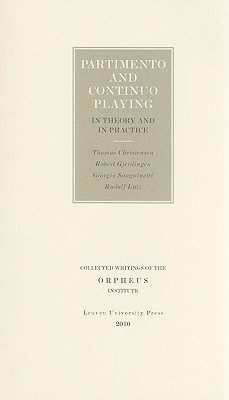
- We will send in 10–14 business days.
- Author: Thomas Christensen
- Publisher: Leuven University Press
- ISBN-10: 9058678288
- ISBN-13: 9789058678287
- Format: 14.7 x 23.9 x 0.8 cm, minkšti viršeliai
- Language: English
- SAVE -10% with code: EXTRA
Partimento and Continuo Playing in Theory and in Practice (e-book) (used book) | bookbook.eu
Reviews
Description
This volume reflects a multidisciplinary approach, with the accent on the interplay between music performance and music theory. Thomas Christensen, in his contribution, shows how the development of tonal harmonic theory went hand in hand with the practice of thoroughbass. Both Robert Gjerdingen and Giorgio Sanguinetti focus on the Neapolitan tradition of partimento. Gjerdingen addresses the relation between the realization of partimenti and contrapuntal thinking, illustrated by examples of contrapuntal imitation and combination in partimenti, leading to the "partimentofugue." Sanguinetti elaborates on the history of this partimentofugue from the early eighteenth until the late nineteenth century. Rudolf Lutz, finally, presents his use of partimenti in educational practice, giving examples of how reviving this old practice can give new insights to composers, conductors, and musicians.
EXTRA 10 % discount with code: EXTRA
The promotion ends in 21d.02:38:33
The discount code is valid when purchasing from 10 €. Discounts do not stack.
- Author: Thomas Christensen
- Publisher: Leuven University Press
- ISBN-10: 9058678288
- ISBN-13: 9789058678287
- Format: 14.7 x 23.9 x 0.8 cm, minkšti viršeliai
- Language: English English
This volume reflects a multidisciplinary approach, with the accent on the interplay between music performance and music theory. Thomas Christensen, in his contribution, shows how the development of tonal harmonic theory went hand in hand with the practice of thoroughbass. Both Robert Gjerdingen and Giorgio Sanguinetti focus on the Neapolitan tradition of partimento. Gjerdingen addresses the relation between the realization of partimenti and contrapuntal thinking, illustrated by examples of contrapuntal imitation and combination in partimenti, leading to the "partimentofugue." Sanguinetti elaborates on the history of this partimentofugue from the early eighteenth until the late nineteenth century. Rudolf Lutz, finally, presents his use of partimenti in educational practice, giving examples of how reviving this old practice can give new insights to composers, conductors, and musicians.


Reviews